This is an Ucaflex, a 35mm single lens reflex camera, produced by UCA-Werkstätten für Feinmechanik und Optik GmbH in Flensburg, West Germany between 1951 and 1952. The Ucaflex takes a unique approach to SLR design with a hybrid reflex mirror and prism viewfinder for focus only and an optical viewfinder for image framing. Two different versions of the Ucaflex exist, the first with a 40mm threaded screw mount and the second with a modified Exakta bayonet mount. The Ucaflex is based on an earlier camera called the Neucaflex, originally built in Jena, East Germany. It was a very short lived model, produced for only about a year and is extremely difficult to find today.
Film Type: 135 (35mm)
Lens: 50mm f/2.8 Schneider-Kreuznach Xenar coated 3-elements in 2-groups
Lens Mount: Ucaflex Bayonet (Modified Exakta Mount)
Focus: 3.5 feet to Infinity
Viewfinder: Rotating Pentaprism for Focus and Optical Viewfinder for Composition
Shutter: Cloth Focal Plane
Speeds: B, 1 – 1/1000 seconds
Exposure Meter: None
Battery: None
Flash Mount: Cold shoe and F/X Flash Sync
Manual: None
The Voncabbage Collection
 In the fall of 2021, I had the opportunity to visit the Voncabbage Collection, one of the largest private collections of cameras in the world. The owner of this collection wishes to remain anonymous, but granted me full access to thousands of rare and unusual cameras, many of which were prototypes, one offs, or rare cameras that many collectors would go their whole lives and never see.
In the fall of 2021, I had the opportunity to visit the Voncabbage Collection, one of the largest private collections of cameras in the world. The owner of this collection wishes to remain anonymous, but granted me full access to thousands of rare and unusual cameras, many of which were prototypes, one offs, or rare cameras that many collectors would go their whole lives and never see.
Although I was able to handle and photograph any camera I wanted, when faced with literally thousands of cameras, there’s only so much time you can spend with each one. The owner let me photograph anything I wanted, but there wasn’t enough time to shoot film in any of them.
This year, I will be sharing some of the photos of cameras I took in a series of Voncabbage Collection reviews, along with whatever I could find about each one.. These reviews will be shorter, and sometimes missing things that I was unable to discover in the short time I handled them, but I’ll still do my best to find whatever I can!
Why This Review Sucks
When I was given the opportunity to visit the Voncabbage collection, I expected to see some really cool cameras I knew I’d likely never see again. What I didn’t expect however, was how overwhelming being around SO MANY cool cameras would be.
The collection is stored in a large house, with cabinets and shelves in various rooms throughout the house. Each cabinet can have as many as 50-100 cameras in or on it, and everything is extremely well kept. Every single camera is unique, without any duplicates. The closest you’ll see to a duplicate camera is if a single model had a major revision that differentiated it from the other version, so even though you might see two Zeiss-Ikon Contax rangefinders, they’re very different Contax rangefinders.

When standing in front of each cabinet or shelf, it would take hours to fully absorb and handle all of cameras on that one shelf, so my approach was to glance over and pick up only the most truly amazing cameras on each shelf and then peel myself away and visit the next cabinet. As I visited another cabinet, things kept getting more and more impressive.
As the hours ticked by and I moved from cabinet to cabinet, it became more and more clear I would never remember everything I handled. Certain models that I otherwise would want to sit there and play with for 20-30 minutes, I only handled for 20-30 seconds before moving on. I had my digital camera with me, hoping to document a small number of the coolest cameras for articles on my site, but the realization that I couldn’t possibly learn everything I needed to know about a particular model, having handled them for such a short time.
The Ucaflex is one of those cameras that I regret not spending more time with as it is very cool. Looking back at the photos I took of it, I wish I had done a better job getting the camera in better lighting, shooting a better pic of the mirror, the bottom of the camera, a through the viewfinder pic, and a better image of the lens mount.
What follows is my best attempt at documenting this fascinating camera in the hope you all learn at least something you didn’t previously know as there is so little info about it out there. For anyone who has an Ucaflex or knows more of the history, please help me fill in the blanks with what you know or things I got wrong, and I’ll be sure to update the review.
History
Prior to World War II, Germany was the world leader in optical instruments and photographic equipment. It did not matter whether you needed a camera lens, a microscope, a pair of binoculars, or even eyeglasses, if you wanted the best, you’d likely be buying something from Germany. Within Germany, a huge amount of the best companies were all in the Dresden area. Sure, great products were made in other areas of the country, but the highest concentration of factories were all in the same area, and therefore, so were the highest concentration of the best optical engineers, precision mechanics, and other skilled laborers.

After the war, while much of Dresden and the surrounding factories were destroyed, many of those workers were still there and needed to find something to do. Germany’s post war economy was devastated, and when it came time to get back to work, these men and women often sought out work in what they knew best.
As a result, a variety of small companies sprung up, hoping to churn out something to sell. Some prewar companies like Balda and Richter resumed making cameras, but other companies that had no pre-war camera products like Braun and King entered in the fray. In addition to existing companies, some new ones popped up as well.
One such company was Feinmechanischen Werkstätten Franz Robert Neubert Jena, who in 1946 began working on some optical products of it’s own. Very little information exists about this company or who Franz Neubert was, but their first product appears to be a copy of the Leica II called the Neuca. Shortly after, or perhaps at the same time, a more ambitious camera called the Neucaflex was built that added elements of a single lens reflex to the body of a Leica rangefinder.
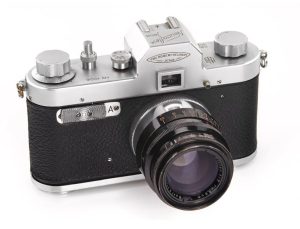
The Neucaflex used the same M39 lens mount as the Leica, but may or may not have had the same flange distance. Information on Leica compatibility is unclear, but the presence of a reflex mirror within the body suggests the lens was pushed out a bit. The Neucaflex has a tall bump on the top plate which housed a highly magnified pentaprism which allowed the photographer to see through the taking lens for focusing, but only a small portion of the center of the image. When it came time to expose the image, a complex system of linkages would move the mirror and prism out of the way, allowing the photographer to see through an optical window above the lens for composing the image.

The Neucaflex is extremely rare, likely due to complexity, low production, lack of brand awareness, and regional distribution, but at some point, Franz Neubert or some of his employees would relocate out west to a far northern Germany town called Flensburg where they would partner with an existing company already there called Optische Werkstätten Mürwik Flensburg which was founded by a former naval engineer named Hans Buschack. In Flensburg, a compact camera called the Elca was being made since 1947. The Elca was a simple camera that shot 24mm x 24mm images on regular 35mm film.
What drew the makers of the Neucaflex to Flensburg is unclear. Perhaps it was to avoid restrictions by the Soviet controlled East German government in Jena, but that’s just a wild guess of mine. Around 1948, the company in Flensburg would change it’s name to Elop GmbH Flensburg and continue production of the Elop and possibly other models.
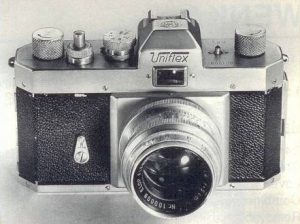
At the first Photokina in 1950, Elop would present a new SLR camera called the Uniflex. This new camera was clearly based off the earlier Neucaflex, built in Jena. Now built in Flensburg by Elop, the Uniflex uses the same concept of a reflex mirror for measuring focus through the lens on the central part of the image, and then swinging out of the way for final image composition through a see through optical window.
At some point after the announcement of the Uniflex, Elop GmbH Flensburg would change it’s name to UCA Werkstätten für Feinmechanik und Optik GmbH Flensburg. As a result, the Uniflex was also renamed the Ucaflex, most likely to align with the new company name.

The Ucaflex would go on sale in early 1951 and differs from the earlier Neucaflex however by switching to a hinged film back rather than a bottom loading film compartment, a larger mirror which required a new 40mm lens mount, the presence of an accessory shoe, flash synchronization, and revised cosmetics.
After it’s release, the Ucaflex was one of a small number of SLR hybrid cameras, the most common similar model was the Corfield Periflex, which used a moving periscope in lieu of a moving mirror and prism which also allowed for through the lens focusing while still offering a bright and easy to use optical viewfinder.
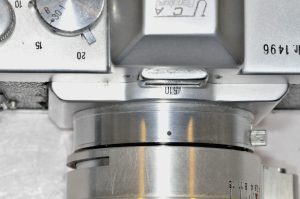
There are two versions of the Ucaflex, the original with the 40mm screw lens mount, and a second which had a modified version of the Exakta mount. I tried to mount an Exakta lens to the Ucaflex, and to my surprise, the bayonets lined up perfectly and I was able to press the lens onto the body, however the location of the locking pin interfered with my ability to fully seat and lock the lens into place. The image to the right shows the Ucaflex with a Zeiss Tessar in Exakta mount held in place on the camera. Had I left it like this, the lens would have fallen right off, so it wouldn’t have been usable.
The Ucaflex had four available lenses made for it. A homemade 6-element Ucalux 5cm f/1.9 lens, and four Schneider-Kreuznach 5cm lenses ranging from f/1.9 to f/3.5. According to a promotional pamphlet which I’ve included below, other focal length lenses from 40mm to 360mm were possibly available, but it is not clear whether any of these were ever made as I’ve found no evidence that they actually existed. The same pamphlet also shows the Ucaflex with a bellows and microscope attachment, possibly suggesting some scientific applications were intended for it.
The following six page promotional pamphlet is the most comprehensive source of information for the Ucaflex available. It is written entirely in German, so if you cannot read German, you’ll need to use a service like Google Translate.
Despite having an innovative design and lenses that would have produced sufficiently excellent images, the Ucaflex did not sell well. The camera was only produced for about a year with less than 1000 thought to have been made. A variety of factors likely prohibited greater success, but the most likely is that the company that produced it simply did not have enough money to compete in what was a growing German camera industry. In September 1952, UCA Werkstätten für Feinmechanik und Optik GmbH Flensburg would be acquired by AGFA and merged into it’s corporate structure. No UCA cameras were produced after the merger with AGFA, but it is thought the Flensburg workers continued to build accessories for AGFA.
The Ucaflex, like many cameras produced in Germany and other countries over the world is a mostly forgotten model, remembered only by the most dedicated of collectors. with such small numbers of these cameras ever made, they are extremely difficult to find, and even if you find one, learning more about their history is extremely difficult.
With what I’ve been able to compile here based on handling a single model and translating a variety of German and Danish articles, I have what is likely the most complete look at the camera history.
My Thoughts
I can’t remember what I was doing when I found it, but at some point in mid 2021, I was researching some other camera and came across some information about an obscure SLR called the Ucaflex. What little information I could find about the camera made it sound interesting and I thought that if there was one person who might have it, it would be Mr. Voncabbage himself, so I sent off a quick message and sure enough, he was happy to share with me some pics of his Ucaflex.
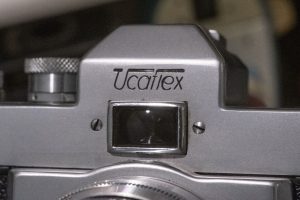
When I had the opportunity to see the collection in person, the Ucaflex was one of the first cameras I sought out. I liked the design of the camera and the unique take on how the through the lens viewfinder worked. I had already reviewed the Corfield Periflex 3 on this site and although the Ucaflex isn’t exactly the same, it takes a similar approach and I wanted to learn more.
Upon handling the Ucaflex, I noticed not just it’s heft, but how well the camera was put together. Often when handling small production cameras by small companies who barely made a blip in the history of photography, the cameras show signs of being unfinished, or at least not up to the same level of quality as those from the bigger manufacturers.
Not with the Ucaflex. If you didn’t know any better, based entirely on tactile feel, the Ucaflex is as good as any other German camera from the era and feels like it might have been from a long running and very successful lineup of cameras. There is no hint of cut corners or cheap construction like you might expect from such a low produced camera. I did not get a chance to put the camera on a scale, but I would predict it comes somewhere in the range of 600-700 grams with the lens mounted.
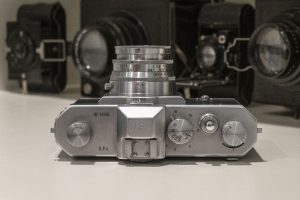
Up top, the Ucaflex has controls where you’d expect to find them on top of any camera. On the left is the rewind knob, next to which is the camera’s serial number and then the prism hump with a very short accessory shoe hanging off the back.
Next is the shutter speed dial with speeds 1/30 to 1/1000. The setting for 1/30 says “30-1” which is the setting for when you need to use speeds slower than 1/30. Beneath the shutter speed dial are engraved numbers from 0 to 20, but these are not slow speeds, rather an adjustable flash sync delay from 0ms for electronic flashes up to 20ms for bulbs. Although I have never seen a manual for the Ucaflex, I have to imagine in that manual would have been a chart with recommended settings for different types of bulbs available at the time.
To the right of the shutter speeds is a chrome shutter release button, film advance lever and manually resetting exposure counter. The exposure counter is additive, showing how many images have been exposed and must be reset to 0 after loading in each new roll of film.
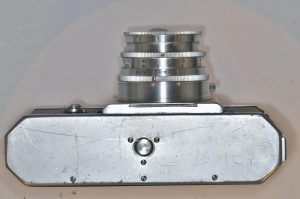
The base of the camera is pretty barren, save for the 3/8″ tripod socket. This is larger than 1/4″ sockets which would soon become common all over the world, so if you were to try and use this camera on a tripod today, you’d need to find a 3/8″ to 1/4″ adapter.
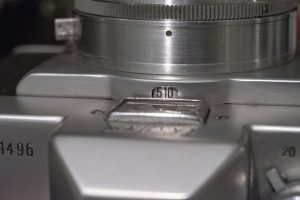
The most interesting thing on the bottom of the camera however, is not actually on it’s base, but rather that knurled ring on the plate just below the lens. Rotating this ring changes numbers seen through a small window above the lens, which is for the slow shutter speeds from 1 to 1/15. If you recall the shutter speed dial on top had a setting for 30-1, but flash sync numbers below it. When the camera is in the 30-1 position, this dial is how you choose a slower speed.
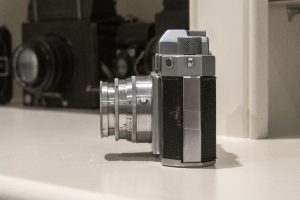
Of the camera’s two sides, the left is far more interesting. Starting with the latch that keeps the film door shut, it works by pressing in on the rectangular middle section while simultaneously sliding the entire latch down. Doing this releases the latch and the right hinged film door swings open.
Above it is the flash sync port, and one of the two strap lugs. Also notice on this side of the lens mount is a release pin for the Ucaflex’s bayonet mount. Earlier Ucaflexes with the screw mount would not have this pin.
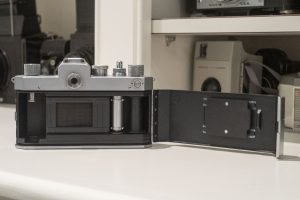
The film compartment is rather ordinary. Film transports from left to right onto a single slotted and fixed take up spool. The inside of the door has a black painted and smooth film pressure plate. There are no dimples or rollers on the inside of the door to aid in film transport, but those kinds of things weren’t yet common when this camera was made.
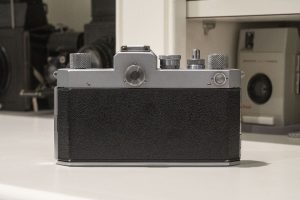
Close the door and the back of the camera has little to see. There’s the circular eyepiece for the viewfinder that is used both for focusing and composition, and off to the far right is a round switch that is used to reset the exposure counter after loading in a new roll of film.

This particular Ucaflex is the second variety with the Exakta based bayonet lens mount instead of the original 40mm screw mount. I mentioned earlier that although the bayonets line up, the pin holding the lens on is not compatible with Exakta lenses, so you must use an actual Ucaflex lens.
Mounting and dismounting the lens is like any other bayonet. Line up the marks on the lens with the body and give it a quick twist. A small locking pin sticking out of the mount holds the lens in place, and must be manually released using the slider just above the 3 o’clock position around the lens. Finally, to the left of the lens mount is a lever for deactivating the film transport when rewinding the film in the camera.
Sadly, I did not capture a through the viewfinder view of the camera, but with the illustration earlier in this document, imagine looking through an SLR with an eye level pentaprism, but instead of seeing the entire image that would be captured on film, you see a highly magnified crop of the center of the image. A small piece of ground glass shows whether the image is in focus or not. This is very similar to how the periscope on the Corfield Periflex works. You can “see focus”, but only in the middle of an image, just like how a rangefinder only shows you focus in the center of the image.
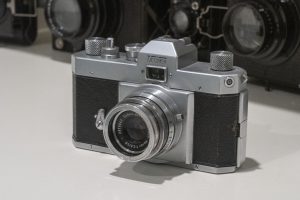
Once you have something that’s in focus, you press down on the shutter release until you feel a stop. As you press down on the shutter release, the reflex mirror begins to rise, getting out of the way of the film plane, and the pentaprism pivots forward, out of the way of the optical viewfinder.
With your finger still maintaining pressure on the shutter release at this top, you can now see through the front viewfinder window above the lens, showing a bright, full image. Although you are no longer seeing light through the lens, you can approximate your composition, similar to how you would on a rangefinder camera. Assuming the distance from you and the object you wish to photograph has not changed since you checked focus, pressing down with a little more force on the shutter release will fire the shutter, exposing your image. Once you’ve exposed your image and lift your finger off the shutter release, the pentaprism and mirror will drop back down to their original positions.
This arrangement is quite clever, and in a way, offers the best of both worlds between a rangefinder and SLR. You get through the lens focus like a normal SLR, but without the darkness often associated with early SLRs. The look through the optical viewfinder is very bright, and although there would be a small amount of parallax error, it likely wouldn’t have been extreme enough for someone to notice for anything but macro shots.
Of course, the Ucaflex was only in production for a very short time and very few were ever made. It would seem that despite it’s clever design, people were either still satisfied with their rangefinders, or for the people still interested in an SLR, were happy with other options out there. The Ucaflex is a fascinating camera with a cool history and neat design. They’re incredibly rare today, so most people reading this aren’t likely to ever see one, but hopefully now you know a little about it, if you ever do!
Related Posts You Might Enjoy
External Links
http://camera-wiki.org/wiki/Ucaflex
http://www.novacon.com.br/odditycameras/Ucaflex.htm
http://www.novacon.com.br/influest12.htm
http://www.ihagee.org/Nonihgcam/nonex2.pdf
http://www.kamerasamling.dk/Artikler%20pdf/Elop%20Flensborg.pdf

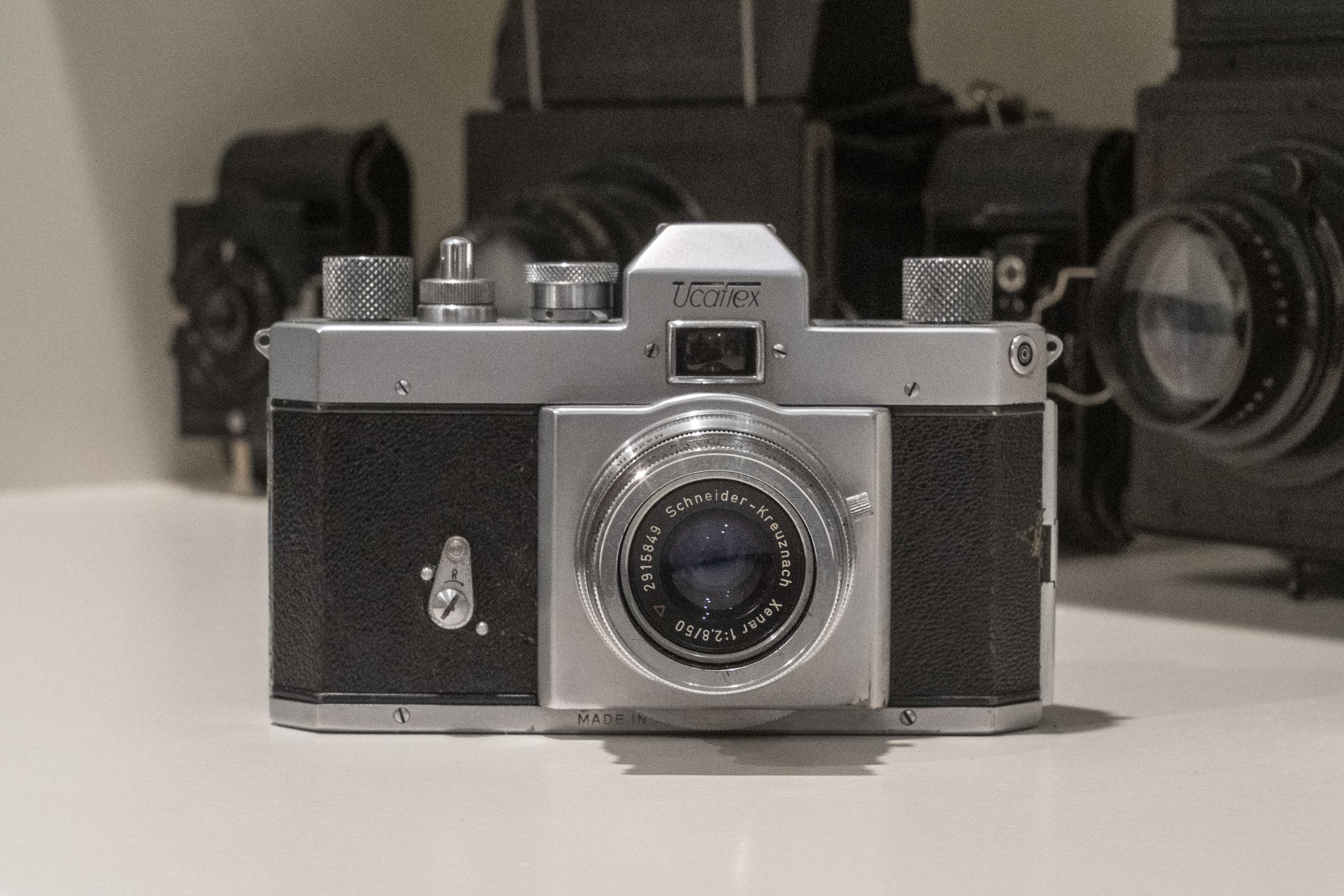
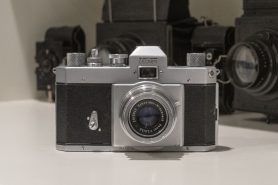
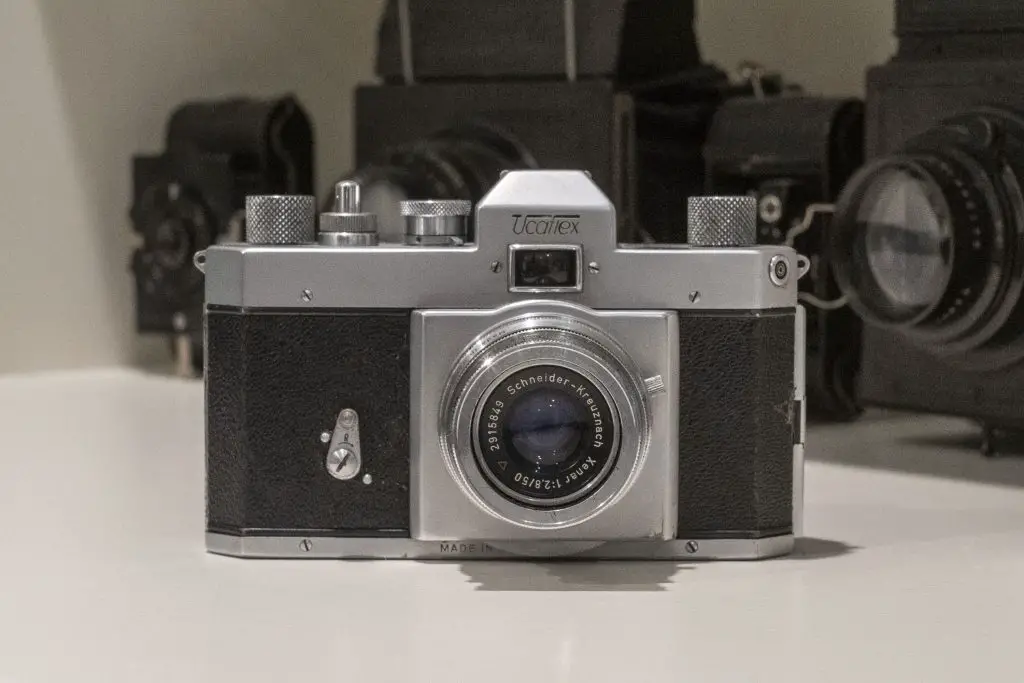
That’s one cool and rare camera. I hope you don’t mind if I offer a couple of corrections/extra details:
The town is Flensburg, not Flensberg. ‘Burg’ means city or burgh in German, whereas ‘Berg’ is mountain.
Indeed, the registration distance of the Neucaflex/Ucaflex was longer than the standard LTM one.
The longer lenses (and 40mm) all must’ve been produced or at least prototyped at some point, because the German ad states that: “…stehen folgende Zusatzobjektiven zur Verfügung“, which means that they were available, and likely produced (as opposed to “vorstellbare”, meaning that they could be made to order). They were also hard-coated (“hart vergütet”, probably to differentiate them from cheaper lenses with soft coatings), and they incorporated extra optics that slid in front of the little ‘window’ on the front to adjust the viewing angle. Focus was still achieved via periscope, just like it is with the regular 5cm lenses.
I hope you get a chance to revisit the Voncabbage collection. It’s wonderful to get this detailed insight into extremely rare cameras, and I’m here for it!
I have corrected the spelling of Flensburg in the article. Thank you for the information about the lenses. I certainly wish I could have spent more time with this camera, possibly even shooting it.
And yes, if I ever make it out to see the collection again, I will come better prepared! 🙂